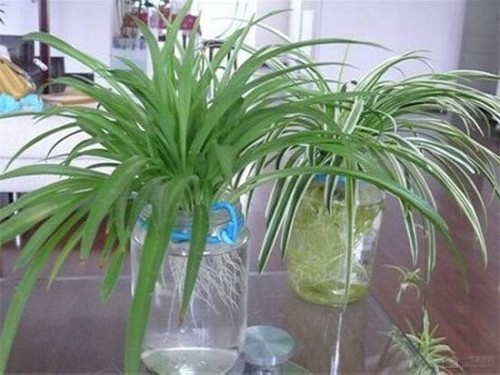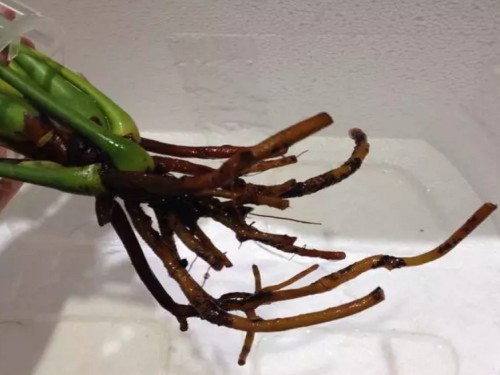What about the rotten roots of hydroponic plants?
People who like to raise green plants know that hydroponic plants are generally easier to grow than soil-grown plants, but hydroponic plants are also easy to rot if they are not well preserved. The so-called rotten root is that the root of the plant turns yellow, black and soft, and gently pull the rhizosphere with your hand, and its epidermis is very easy to tear off, leaving only the Lignified part. Smell the roots of the plant, and the smell. If the roots of plants are rotten, the water of hydroponic plants will also smell bad.
If you don't want your beloved green plant to die like this, let the editor share some tricks with you. However, the so-called know yourself and know the enemy can win a hundred battles. In order to overcome the rotten root, let's first understand the cause of its appearance.

1. How to judge whether hydroponic plants have rotten roots
1. Observe the root of the plant. If you find that the root has turned yellow, black and soft, and gently pull the root with your hand, the epidermis is very easy to tear off, leaving only the Lignified part, indicating that the root of the plant has rotted.
2. Smell the water with your nose. If the water smells bad, the root system may also rot and deteriorate.
3. Smell the root with your nose. If there is a bad smell in the root, it proves that the root is rotten.
2. Treatment of rotten roots of hydroponic plants.
1. Take out the soaked flowers, rinse with flowing water, and clean the original cultivation container at the same time. After washing, put the flowers into the original utensils and grow them with clean water. Change the water once every 1-2 days. Wait for the plant to adapt to the environment, and then add the nutrient solution after the initial sprouting new root is stable.
2. After finding the rotten root, the rotten part must be cut off in time. Generally, the rotten root is gradually rotten upward from the root tip and pruned until it is cut to the normal root system. After changing water, pay attention to observe that if rotten roots continue to appear, they should be dealt with in a timely manner.
3. The treated flowers are soaked in 0.5% potassium permanganate solution and sterilized for 10-20 minutes, and 0.5% potassium permanganate solution is sprayed into the original cultivation container for disinfection.
Third, the causes of rotten roots of hydroponic plants.
1, rotten roots because you did not change the water in time, the muddy water quality is easy to rot roots. There are residual plant debris in the water, which causes the water quality to deteriorate. If the water quality is found to be relatively turbid or has a strange smell, the water should be changed in time to ensure the normal growth of plants.
2. Ulceration begins at the end of the flower root, which often occurs in the hot summer. The main reason is that with the continuous rise of air temperature, the water temperature will also rise, the propagation of microorganisms will be accelerated, the dissolved oxygen will decrease, and the water quality will deteriorate. If the nutrient solution is added incorrectly, so that the nutrient solution concentration is too high, it is easy to cause hydroponic plant root rot.
3. The water flooded all the roots and even the rhizomes. Generally, the best cultivation is to leave half of the roots in the water and the other half in the air. This can greatly increase the oxygen supply of plant roots and effectively reduce the occurrence of root rot.
4. Fester from the root of the leaf diameter, the main reason is that many flowers like to buy containers with fixed planting baskets as containers. "the continuous damage to flowers caused by cutting the sharp corners formed at the bottom of the planting basket". Wrapping the flower roots with plastic sheeting in the production process reduces the first damage to the flower roots, but when the plastic sheeting is removed, the damage has only just begun. every time you change water, disinfect, adjust the pattern, move the position, add water or rinse the flowers with water will aggravate the continuous damage to the plastic tip cut face of the flowers, although these wounds are very small. But can a flower with a festering wound always live well?
The rotten roots of hydroponic plants are generally divided into two situations:
The first situation is that it begins to fester from the root of the leaf diameter (where the planting basket is stuck at the root of the flower or the root of the leaf diameter). The main reason is "the continuous damage to flowers caused by cutting the sharp corners formed at the bottom of the planting basket." wrapping the flower root with plastic sheeting in the production process reduces the first damage to the flower root, but when the plastic sheet is removed, the damage is just beginning. Each change of water, disinfection, flower pattern adjustment, moving position, adding water or washing flowers with water will aggravate the continuous damage caused by the plastic corner cut to the flowers. Although these wounds are small, can a flower always live well with a suppurative wound?
Those hydroponic plants that took three months to domesticate do not rely on the recovery elasticity of plastics to hold the roots of flowers, but rely on the extensive use of nylon turns to fix the baskets and flowers. This fixation is very firm and stable. As a result, there is no displacement between the plastic corner or blade section of the flower root and the flower root. The result is that each change of water, disinfection, flower shape adjustment, moving position, adding water or rinsing flowers with water will not cause lasting damage to flowers.
In the first case, the following work needs to be done:
Method 1: a large number of nylon turns are used to fix between the planting basket and the flowers, and there must be no displacement between the flowers and the planting basket, so as to prevent the plastic sharp corners or blades stuck in the roots of the flowers from causing continuous damage to the flowers.
Way 2: grind the "traditional planting basket" round, or add soft cloth, foam, tape, without the plastic sharp corners or blade sections that get stuck in the roots of flowers, there will be no continuous damage to flowers.
The second situation is that it begins to fester from the ends of flower roots, which often occurs in hot summer. the main reason is that as the air temperature continues to rise, the water temperature will also rise, the reproduction of microorganisms will be accelerated, the dissolved oxygen will decrease, and the water quality will deteriorate. if the nutrient solution is added incorrectly, so that the nutrient solution concentration is too high, it is easy to cause hydroponic plant root rot.
In the second case, the following work needs to be done:
1. Remove or remove all the rotten roots, and the infected part of the stem should also be removed.
2. The repaired flowers are soaked in 0.5% potassium permanganate solution for 10-20 minutes and sterilized, and 0.5% potassium permanganate solution is sprayed into the original cultivation container for disinfection.
3. Take out the soaked flowers and rinse them with water in the water pipe. At the same time, clean the original cultivation container.
4. Put the washed flowers into the original cultivation container, and then grow them with clean water.
5. Change the water once every 1-2 days, only change the clear water and not add the nutrient solution. The water quality is clear, which can reduce the number of water changes. New roots can sprout after 10-15 days of maintenance.
6. If the weather is hot, it is still cultivated in clear water. Wait for the temperature to stabilize at 18-25 degrees, and then add nutrient solution to cultivate.
Finally, no matter what flowers, always need sunlight, after the completion of the above work, or because the hydroponic plants should be put on the balcony to shine on the sun to enhance immunity.
Time: 2019-06-01 Click:
- Prev

What about the rotten roots of hydroponic orchids?
Flower friends who like hanging orchids always like to pinch a few branches and leaves and keep them in the water. Careful flower friends find that before long, the roots of hanging orchids begin to rot. So, what about the rotten roots of hydroponic hanging orchids? If the root system of the orchid has rotted in the water, it is best to clean the bottle and the root system of the orchid first, and cut off all the rotten roots.
- Next

What about the rotten roots of water-cultivated red palms?
The key to the hydroponic cultivation of Anthurium andraeanum is to ensure the healthy growth of the root. Anthurium andraeanum is aerial and needs enough oxygen, but the oxygen in the water is far less than that in the soil, and many reasons will cause root rot. The following editor introduces the methods to prevent the rotting roots of Anthurium andraeanum in hydroponics. The growth of hydroponic plants is often not as strong as that of soil culture.
Related
- Fuxing push coffee new agricultural production and marketing class: lack of small-scale processing plants
- Jujube rice field leisure farm deep ploughing Yilan for five years to create a space for organic food and play
- Nongyu Farm-A trial of organic papaya for brave women with advanced technology
- Four points for attention in the prevention and control of diseases and insect pests of edible fungi
- How to add nutrient solution to Edible Fungi
- Is there any good way to control edible fungus mites?
- Open Inoculation Technology of Edible Fungi
- Is there any clever way to use fertilizer for edible fungus in winter?
- What agents are used to kill the pathogens of edible fungi in the mushroom shed?
- Rapid drying of Edible Fungi

